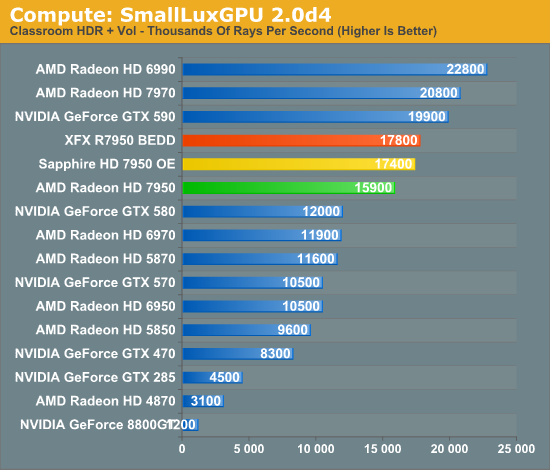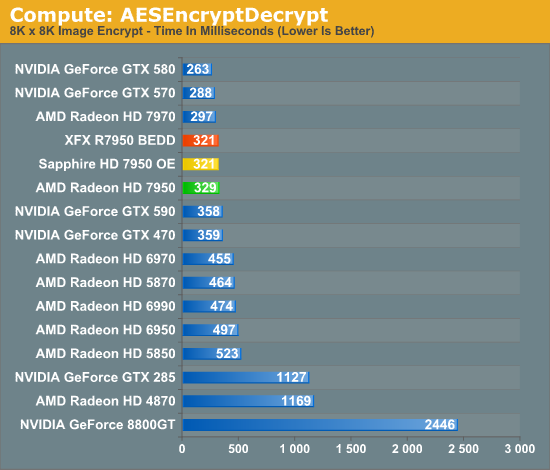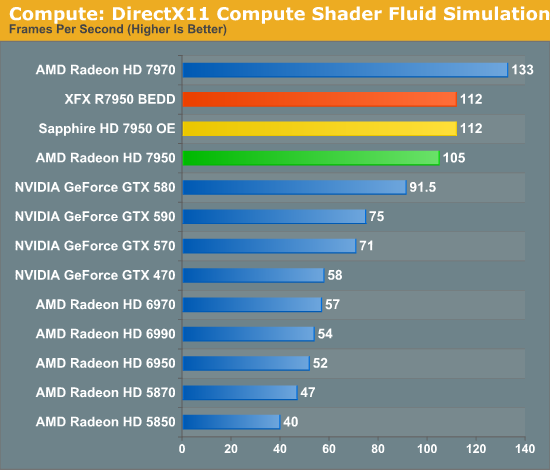AMD Radeon HD 7950 Review Feat. Sapphire & XFX: Sewing Up The High-End Market
by Ryan Smith on January 31, 2012 9:02 AM ESTCompute Performance
Moving on from our look at gaming performance, we have our customary look at compute performance. Since compute performance is by definition shader bound, the 7950 is at a bit of a disadvantage here compared to gaming performance. Whereas ROP performance scales with the core clock, shader performance is hit by both the reduction in the core clock and the disabled CU array.
Our first compute benchmark comes from Civilization V, which uses DirectCompute to decompress textures on the fly. Civ V includes a sub-benchmark that exclusively tests the speed of their texture decompression algorithm by repeatedly decompressing the textures required for one of the game’s leader scenes. Note that this is a DX11 DirectCompute benchmark.

AMD’s greatly improved compute performance continues to shine here, though in the case of Civilization V it’s largely consumed by just closing the previously large gap between the GTX 500 series and the Radeon HD 6000 series. As a result the 7950 falls ever so short of the GTX 580, while the factory overclocked Sapphire and XFX cards give the 7950 enough of a push to come within 5% of the 7970.
Our next benchmark is SmallLuxGPU, the GPU ray tracing branch of the open source LuxRender renderer. We’re now using a development build from the version 2.0 branch, and we’ve moved on to a more complex scene that hopefully will provide a greater challenge to our GPUs.

Under SmallLuxGPU the 7970 enjoyed a large lead over the GTX 580, and this continues with the 7950. Even though the 7950 is well behind the 7970—to the tune of 24%—it’s still 33% ahead of the GTX 580 and the lead only grows from there. Meanwhile the XFX and Sapphire cards can catch up to the 7970 somewhat, but as this is truly a shader-bound test, you can’t make up for the lack of shaders units on the 7950.
For our next benchmark we’re looking at AESEncryptDecrypt, an OpenCL AES encryption routine that AES encrypts/decrypts an 8K x 8K pixel square image file. The results of this benchmark are the average time to encrypt the image over a number of iterations of the AES cypher.

In spite of being a compute benchmark, AESEncryptDecrypt is not particularly sensitive to GPU performance, showcasing the impact that setup times can have. The 7950 trails the 7970 by 10%, and overclocking doesn’t change this much. Unfortunately for AMD NVIDIA is still the leader here, showing that AMD’s compute performance still has room to grow.
Finally, our last benchmark is once again looking at compute shader performance, this time through the Fluid simulation sample in the DirectX SDK. This program simulates the motion and interactions of a 16k particle fluid using a compute shader, with a choice of several different algorithms. In this case we’re using an (O)n^2 nearest neighbor method that is optimized by using shared memory to cache data.

With the compute shader fluid simulation we once again shift back into a compute task that’s much more shader-bound. The 7950 only reaches 80% of the performance of the 7970, once more proving the real impact of losing a CU array. This is still enough to handily surpass the GTX 580 however, with the 7950 taking a 15% lead.










259 Comments
View All Comments
chizow - Thursday, February 2, 2012 - link
Nonsense, we already covered this. GTX 280 was almost 2x faster than the 8800GTX and about the same performance as the 9800GX2. A true flagship card.ATI exceeded everyone's expectations with the RV770 but grossly underpriced their card, which is the only reason Nvidia was forced to drop their price.
The difference this time around, is that the 7970 does NOT deserve the premium pricing relative to last-gen. The only way AMD will get off the hook is if Nvidia makes the same mistake and prices based on last-gen performance as well and prices their flagship at like $750 lol. It may happen, but I doubt it.
chizow - Thursday, February 2, 2012 - link
Rofl, except I have mountains of historical evidence that back my points, while your nonsensical pricing schemes would have us deciding between new cars or new GPUs.Also back to that running a business part. Its obvious you have no clue what it takes to run a business.
AMD is basically stealing from Peter to pay Paul, they're trading short-term gains for long-term profit by risking the relationship of their most loyal customers. In this business as in any other, customer satisfaction and brand loyalty is paramount.
Unlike their fanboys, it would be criminally negligent of AMD not to consider the pricing of upcoming products from their main competitor: Nvidia. To that end, 28nm parts from Nvidia are imminent, ignoring this fact is just bad business.
We'll see how this shakes out, but honestly I can't see AMD getting off unscathed here unless Nvidia prices Kepler outrageously.
Galidou - Sunday, February 5, 2012 - link
LOL he's fun, while Nvidia made the worse pricing decision in the world like 9800gx2 priced 150$ less than a GTX 280 that performed LESS is so much funny, last gen part vs new gen part comparison here you come....chizow - Sunday, February 5, 2012 - link
What's fun is you can get 2x last-gen parts for cheaper than 1x next-gen parts anytime you want it.Would you buy 2xGTX 460 today instead of a GTX 580 or 7970? Most people would say no, but for those who want it, 2xold is cheaper and faster than 1xnew.
Galidou - Sunday, February 5, 2012 - link
Well if you can do it anytime, what's new with 7970? Ahh it should of driven the prices down, unlike Nvidia's coming up with new gpus to drive the price up. Nvidia up the prices and ATI makes them go down here's your history of things... well things can change, we don'T live in a stable world.Galidou - Sunday, February 5, 2012 - link
Lotsa people already answering to you saying that you make no sense. My philosophy teacher once tole me: If someone come up to you and tells you: ''Hey you are a horse'' you can doubt, a second one comes to you and says the same thing, well you gotta start thinking a little bit, and if a third one comes and tells you the same thing, you should start thinking about buying a saddle.chizow - Thursday, February 2, 2012 - link
And to base buying decisions without acknowledging the 800lb gorilla in the room (Kepler) while simultaneously ignoring the 6 ton elephant in the room (history) would be a monumental mistake.Congrats at successfully trying to manage both!
chizow - Thursday, February 2, 2012 - link
LMAO.See here's the exact flaw in your argument.
AMD doesn't know what Nvidia's performance will be with Kepler.
But they've priced their new product with the assumption Kepler offers no gain, no increase in performance over Fermi.
That's the only possible way they could justify basing their new next-gen, next-process part using old part prices.
This is a massive error in calculation, because unless you're completely oblivious it should be clearly obvious Kepler could beat Tahiti if it were nothing more than a die-shrink of Fermi with higher clocks. 15-25% is NOTHING when looking at a new process node and new architecture, its more of what you would expect from a refresh.
But its OK, despite your claims you have no idea how this industry works, if you did you'd immediately acknowledge the prices AMD is asking for simply aren't justified with all things considered.
chizow - Thursday, February 2, 2012 - link
Because that is what people who are interested in these parts base their buying decisions on. There's not enough incentive otherwise, its not like GPUs expire every 2 years.chizow - Thursday, February 2, 2012 - link
There wouldn't be a problem if the 7950 launched 14 months ago, today its might as well be an exhibit at Jurassic Park.And the 580 for $500? Anyone who has a 580 has put a lot of mileage on those treads and gotten their money's worth. It'll get retired soon enough though, right next to that 7950.